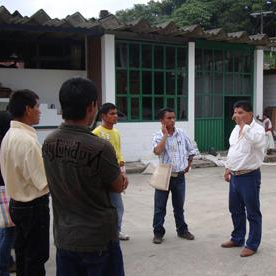|
Summer 2015 Alumni Newsletter
15 Years of Environmental Leadership - Reflections and Looking Ahead
|

Dear ELP-ers,
This year we are celebrating our 15th anniversary! When we started in 2001, there was a strong sense of hope. The Cold War was over and people expected growing cooperation among nations. Climate change has been recognized as a big global threat and the Kyoto protocol was viewed as a key for an integrated coordinated solution. The Millennium Development Goals (MDGs) were established and plans to achieve them (by 2015) were introduced. Things did not turn out as expected.
Read full article
|
|
Thank you to the
Beahrs ELP Alumni Newsletter Editorial Committee for your active support and contribution to this newsletter. Akiko Segawa (Japan) and Annibeth Jacob (Brazil) from the 2014 ELP cohort were the two editors of this newsletter.
|
|
|
Noureddin & Khaled meet!
From March 15th to 21st, 2015, Khaled Sassi, an ELP 2014 alumnus from Tunisia, visited CIHEAM-IAM of Bari for a one-week collaboration under the framework of a research study on Mediterranean Food Waste and Losses (FWL) - The Case of Tunisia.
Click here to learn more about Khaled's meeting with Noureddin Driouech, an ELP 2012 alumnus!
|
|
ELP Hosts 1st Webinar for Alums!
As part of the ELP alumni network activities, the ELP organized its first ever webinar on Green Buildings. Held on April 8, 2015, the webinar was led by Greg Kight, National Director of Sustainable Design at Jacobs Engineering, USA.
|
|
ELP Alum Publishes New Book on Energy Efficiency!
We are delighted to share that
Ming Yang, ELP 2013 alum from the Global Environment Facility, Washington DC
recently published a new book on Energy Efficiency.
Heartiest congratulations to Ming from the entire ELP family!
|
|
|
|
Reflections and Looking Ahead
|

The first time I heard something about the Beahrs ELP Program was in Nairobi, Kenya at the Ecoagriculture Conference (held in 2004) where I met Dr. Robin Marsh, the co-director of the program at that time. She explained to me clearly what the program's aim was and motivated me to apply. I analyzed it but perhaps I thought I was too young then to fulfill the program's experience requirements.
|
It has been ten months since I participated in the Beahrs Environmental Leadership Program of the University of California, Berkeley. I can proudly say that mine is one of the many lives touched and changed by the program since it started in 2001. Having had the rare chance of participating in the ELP, having learned from the most credible experts in the field has changed me in many ways.
Read Full Article
|
|
I feel very lucky that I was in the first cohort of the ELP in 2001, and to be honest, the ELP program has had a very big influence on my career. For the past decade, China has moved very fast to achieve social economic development. Livelihoods have been greatly improved; however, environment improvement will be a lasting topic in the future.
|
|
The ELP was a great experience in my life; it improved my knowledge and skills for my work in sustainable development. Itīs a unique program in the world where we can meet different people from many countries and cultures who are working and contributing to global change related to the sustainable management of natural resources.
|
|
My career path in sustainability started with environmental journalism and communications. The environment has influenced my entire life. Even as a child, I knew I should do more for our planet. Mines with red smoke spewing over factories and dust-loaded air... This was a typical picture from my childhood in a small town in Debaltseve in the Doneck region in Ukraine.
|

For fifteen years, I have been building my resume as a proven social entrepreneur and making an impact felt along the Jukskei River in Johannesburg, South Africa. As a result of my involvement with UC Berkeley, Ashoka and the Clinton Global Initiative, the impact of my work has become known in many countries around the world.
|
Although nearly one year has passed, the memory of participating in the Environmental Leadership Program (ELP) in 2014 is still vivid and strong in my mind. The program opened up a new world in my academic life - urban planning. From this program, I saw light in what I thought might be eternally dark in the past. I was really enthused after Prof. Ananya Roy's lecture on Urban Planning for Sustainable Development.
|
|
Nowadays, as a scientist, you need to go beyond peer-reviewed publications and make yourself accessible in different formats to a broader audience including non-scientists, among whom some are decision makers. This can be done by publishing in a public journal, newsletter, blog, etc.
|
We all have heard about the additive manufacturing technology called 3D printing. This is the process of producing a three-dimensional object from a digital design. This process includes the deposition of successive layers of material (plastic, steel, aluminum, silver, gold, etc.), extrusion of material from a basin of liquid and its solidification when it passes through a laser beam.
|
|
In response to growing concerns about climate change, the global community adopted the UN Framework Convention on Climate Change (UNFCCC) in 1992. The Kyoto Protocol (KP) was adopted five years later in 1997 at the third Conference of the Parties (COP 3), with legal commitments for mitigation and an agreement for a five-year commitment period from 2008 to 2012 to meet the mitigation commitments.
|
|
|
|
|